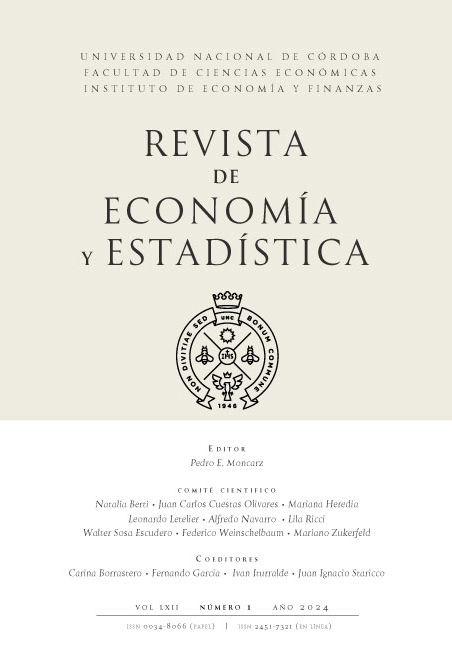30 years after Ouro Preto. A contemporary response to the region's international integration
DOI:
https://doi.org/10.55444/2451.7321.2024.v62.n1.47855Keywords:
MERCOSUR, Multilateralism, RegionalismAbstract
The functioning of international trade today is characterized by a tension between the erosion of the rules of the multilateral system established since the post-war period and the parsimony of its development with the creation of new multilateral agreements with more disciplines to be harmonized. In this context, after more than three decades of existence, MERCOSUR faces two related challenges. On the one hand, to improve the functioning of the meager intraregional trade, for which the main problems are identified and different alternatives for change are proposed. On the other hand, the main challenge is to break out of the protectionist trap that has characterized its entire development and which is at the root of its poor performance in signing preferential agreements with third countries. The objective is to increase the openness of its own market and improve the conditions of access to third markets. Thirty years after the Ouro Preto meeting, there is no customs union, nor is there a path towards one. Different paths are proposed to achieve a regional format that can be applied and overcome the negative status quo.
This article has been published at the invitation of the Journal's Editorial Team.
Downloads
References
Baldwin, R. (2022). The peak globalisation myth: Part 1. VoxEU//Columns, 31 de agosto de 2022. https://cepr.org/voxeu/columns/peak-globalisation-myth-part-1.
Baldwin, R., y Low, P. (2009). Multilateralizing regionalism: Challenges for the global trading system. World Trade Organization, Cambridge University Press.
Estevadeordal A., Kahn T., y Werner, A. (2024). Latin American in the new geometry of global supply chain. Background paper, Georgetown Americas Institute, Georgetown University.
Fajgelbaum P. y Khandelwal A. (2021). The economics impacts of the US-China trade war. NBER Working Paper Series, Working Paper 29315. http://www.nber.org/papers/w29315.
Fajgelbaum, P., Goldberg, P., Kennedy, P. Khandelwal, A. y Taglioni, D. (2024). The US China Trade War and Global Reallocations. American Economic Review: Insights, 6(2), 295-312.
Global Trade Alert (2023). G20 Trade Policy Factbook. St. Gallen Endowment for Prosperity Through Trade.
Moncarz, P., Rovira, F., Villano S. y Vaillant, M. (2024a). Impactos del CPTPP y el ingreso de nuevos miembros, China y Uruguay: aplicación de un Modelo Gravitatorio Estructural de Comercio Dinámico. Documento de Trabajo de la Academia Nacional de Economía de Uruguay.https://www.acadeco.com.uy/pharos/Impactos_del_CPTPP.pdf.
Moncarz, P., Rovira, F., Villano S. y Vaillant, M. (2024b). The dynamic effects of the CPTPP and new member accessions. Trabajo presentado en “Seminario Los países del MERCOSUR y los mercados asiáticos”, 12 de noviembre de 2024, UCU-BS, DECON-FCS-UdelaR, Pharos ACADECO.
Sanguinetti, P. y Vaillant, M. (2023). Reto global del cambio climático: implicancias para América Latina y el Caribe. Búsqueda, consulta del 6 de diciembre de 2023. https://www.busqueda.com.uy/Secciones/Reto-global-del-cambio-climatico-implicancias-para-America-Latina-y-el-Caribe-uc59282.
Sanguinetti, P. y Vaillant, M. (2024a). Precios del carbono y otras regulaciones ambientales: consecuencias para el comercio y su impacto en América Latina. Búsqueda, consulta del 17 de enero de 2024. https://www.busqueda.com.uy/Secciones/Precios-del-carbono-y-otras-regulaciones-ambientales-consecuencias-para-el-comercio-y-su-impacto-en-America-Latina-uc59736.
Sanguinetti, P. y Vaillant, M. (2024b). El desafío de compatibilizar cambio climático y comercio en Latam y el Caribe. Búsqueda, consulta del 13 de marzo de 2024. https://www.busqueda.com.uy/Secciones/El-desafio-de-compatibilizar-cambio-climatico-y-comercio-en-Latam-y-el-Caribe-uc60359.
Downloads
Published
Issue
Section
License

This work is licensed under a Creative Commons Attribution-NonCommercial-NoDerivatives 4.0 International License.
Authors who have publications with this journal agree to the following terms:
Authors retain their copyright and grant the journal the right of first publication of their work, which is simultaneously subject to the Creative Commons Attribution-NonCommercial-NoDerivatives 4.0 International License that allows third parties to share the work provided that its author and first publication in this journal are indicated.
Authors may adopt other non-exclusive licensing arrangements for distribution of the published version of the work (e.g. depositing it in an institutional telematic archive or publishing it in a monographic volume) as long as the initial publication in this journal is indicated.
Authors are allowed and encouraged to disseminate their work via the Internet (e.g. in institutional telematic archives or on their website) before and during the submission process, which can lead to interesting exchanges and increase citations of the published work. (See The Open Access Effect)














